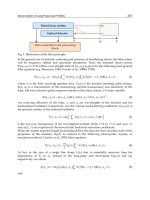Behaviour of Electromagnetic Waves in Different Media and Structures Part 14 doc
Bạn đang xem bản rút gọn của tài liệu. Xem và tải ngay bản đầy đủ của tài liệu tại đây (4.99 MB, 30 trang )
Behaviour of Electromagnetic Waves in Different Media and Structures
378
We prefer to express physical quantities by laboratory time
0
x rather than proper time
τ
. To
do so, we first calculate
0
2
22
00 0
2
00
2
22
00 0
(0)
(0) [ 2 ( 4 ) ]
(0) [ ( 4 ) ]
(0) [2 ( 4 ) ] ]
=
−−+Ω
+Ω
=
+Ω −
dt x
d
xZexpB
xexpB
xexp B Z
τ
ττ
ττ
ττ
(61)
from Eq. (54). Using integral formula
21/2 1
(1) cosh()
−−
−=
xdx x,we obtain
2
00
2
22
0
00 0
00 0
12 1
0
2
00 0 0
(0) [ ( 4 ) ]
(0) [2 ( 4 ) ] ]
(0) (0) (0)
{cosh [ [ ( 4 ) ]] cosh [ ]}
(4)
−−
+Ω
=
+Ω −
=+Ω−
+Ω
xexpB d
t
xexp B Z
xx x
exp B
BZ Z Z
τ
τττ
ττ
ττ
τ
, (62)
in getting this result, we have assumed that initial laboratory time 0
=t corresponds to initial
proper time 0
=
τ
.
The distance of electron away from the origin varies with the laboratory time
t can be
written out according to Eqs. (54) and (58) and the result is
0
2
0
0
/
[( 4)]
/(0)
−=− = − +Ω
Z
dr dr d
exp B
dt dt d x
τ
ττ
τ
. (63)
If we can express the right hand side of this equation by the expression of
t
, then we get the
equation describing
r changing with laboratory time
t
. From Eq. (62), after some calculation
we can obtain a quadratic equation of
2
0
[( 4)]+Ωexp B
ττ
, which is
222
000
2
0
22
0
22
00
[2(4)]2[(4)]cosh[(4)]
1
cosh [ ( 4 ) ] 0
(0) (0)
+Ω − +Ω +Ω
++ +Ω=
exp B exp B B t
Z
Bt
xx
τττττ
τ
.
It is easy to solve this equation and the result is
22 2
00 0
0
1
[( 4)]cosh[( 4)] sinh[( 4)]
(0)
+Ω = +Ω ± +Ω
ex
p
BBtBt
x
τττ τ
. (64)
We know that when the electron is stationary,
0
(0) 1=
x
and =t
τ
. So we should take the “ + “
in Eq. (64), and Eq. (63) becomes
0
22
00 0
(0)cosh[ ( 4 ) ] sinh[ ( 4 ) ]
−=
+Ω + +Ω
Z
dr
dt x B t B t
ττ
.
The Influence of Vacuum Electromagnetic Fluctuations on the motion of Charged Particles
379
This equation can be easily solved and the result is
0
22
00 0
0
0
2
00 0
0
00
121
0
2
00 0
(0) ( )
(0)cosh[ ( 4 ) ] sinh[ ( 4 ) ]
2
()
(4)[(0)1](2)[(0)1]
2(0)1 (0)1
{tan [ [ ( 4 ) ]] tan [ ]}
(4) (0)1 (0)1
−−
−=
+Ω + +Ω
=
+Ω + + −
++
=+Ω−
+Ω − −
t
t
Zdt
rrt
xBtBt
Z
dexp y
Bxexpyx
xx
exp B t
Bx x
ττ
τ
τ
τ
.
So the final expression of the electron’s distance away from the origin expressed by the
laboratory time is
00
121
0
2
00 0
2 (0) 1 (0) 1
( ) (0) {tan [ [ ( 4 ) ]] tan ( )}
( 4 ) (0) 1 (0) 1
−−
++
=− +Ω−
+Ω − −
xx
rt r exp B t
Bx x
τ
τ
, (65)
which explicitly shows the inward spiral characteristic of the electron’s planar motion with a
constant magnetic field along its normal direction. Classically the final destiny of electrons
performing such a motion is falling into the origin.
For ultrarelativistic electrons,
0
(0)
x is very large and
1
00
tan [ ( (0) 1)/( (0) 1)] /4
−
+−
xx
π
.
Using Eq. (65), We can estimate the laboratory time needed for an ultrarelativistic electron to
decrease its the distance from
(0)r to (0)/2r , and the result is
2
0
22
00
11tan[(4)(0)/4]
ln
(4)1tan[(4)(0)/4]
++Ω
=
+Ω − +Ω
half
Br
t
BBr
τ
ττ
.
The initial value
(0)r can be approximated by that of the situation without considering the
radiation reaction effects, namely
0
(0) /≈
rxB,so
ha
ff
t can be written as
2
00
22
000
11tan[(4)(0)/4]
ln
(4)1tan[(4)(0)/4]
++Ω
=
+Ω − +Ω
half
BxB
t
BBxB
τ
ττ
. (66)
However, due to
0
τ
being a very small quantity, we are justified to further simplify this
expression and the result is
00
3
(0) (0)
10
2
−
half
xmc x
t
eB B
seconds for electrons which shows that
hal
f
t has little relationship with vacuum fluctuations.
For ultrarelativistic electrons, according to Eq. (64), we have approximate expression
22
00
[( 4)]cosh[( 4)]+Ω +Ωex
p
BBt
τττ
,
so the energy of electrons can be simplified as
22
00 0
2
2
000
222
00 0
() cosh[ ( 4 )] cosh[ ( 4 )]
(0) (0)sinh[ ( 4 ) ]
(0)cosh [ ( 4 ) ]
+Ω +Ω
+Ω
+Ω −
xBtBt
xxBt
xBtZ
ττ τ
τ
τ
.
Behaviour of Electromagnetic Waves in Different Media and Structures
380
The ratio of two
00
()/ (0)
xx
τ
’s respectively with and without the considerations of vacuum
fluctuations is
00
2
00
[()/(0)]
14
[()/(0)]
−Ω
with
without
xx
/
B
xx
τ
τ
, (67)
which shows that the effect of the vacuum fluctuations. We look forward to seeing that this
result would be tested in future experiments. The nonzero effects of vacuum fluctuations
had been recognized in microscopic world long time ago, such as the Lamb shift and the
Casmir effect etc. However, whether or not the vacuum fluctuations has a relationship with
the radiation reaction for the motion of charges is still an open question. The planar motion
of high energy electrons with a constant magnetic field perpendicular to its moving plane
provides a possible experimental scheme to test this viewpoint.
7. Conclusion
In this chapter, we presented a new reduction of order form of LDE, which coincides with
that obtained by the method of Landau and Lifshitz in its Taylor series form. Using the
classical version of zero-point electromagnetic fluctuating fields of the vacuum, we obtained
the contributions of vacuum fluctuations to radiation reaction of a radiating charge up to
the
2
0
τ
term. Then we use the obtained reduction of order equation of LDE including the
radiation reaction induced by external force and vacuum fluctuations up to the
2
0
τ
term,
which is accurate enough for any macroscopic motions of charges and even applicable to the
electron’s motion of a hydrogen atom due to
0
τ
being extremely small, to study the one-
dimensional uniformly accelerating motion produced by a constant electric field and the
planar motion produced by a constant magnetic field. Our calculations show that for any
one-dimensional uniformly accelerating motion the velocity of charges has a limit value and
almost all puzzles associated with this special motion disappear; while the planar motion of
electrons provides an experimental scheme to test the conjecture that the interaction
between charged particles and the vacuum electromagnetic fluctuations is anther
mechnisim for the charge’s radiation reaction, which plays a dominant role only for one-
dimensional macroscopic motions of charged particles.
8. Acknowledgment
This work was supported by the postdoc foundation of Shanghai city, China. The author
would like to thank Dr Hui Li for reading the manuscript and proposing fruitful comment
on the content of this chapter.
9. References
Aguirregabiria, J. M., (1997), Solving Forward Lorentz-Dirac-like Equations, J. Phys. A: Math.
Gen, Vol. 30, pp. 2391-2402.
Boulware, D., (1980), Radiation from a Uniformly Accelerated Charge, Ann. Phys, Vol. 124,
pp. 169-188.
The Influence of Vacuum Electromagnetic Fluctuations on the motion of Charged Particles
381
Boyer, T. H., (1980), Thermal Effects of Acceleration through Random Classical Radiation.
Phys. Rev. D, Vol. 21, pp. 2137-2148.
Bell, J. S., & Leinaas, J. M., (1983), Electrons as Accelerated Thermometers, Nucl. Phys B, Vol.
212, pp.131-149; (1987), The Unruh Effect and Quantum Fluctuaions of Electrons in
Storage Ring, Nucl. Phys. B, Vol. 284, pp. 488-508.
Chen, P., & Tajima, T., (1999). Testing Unruh Radiation with Ultraintense Lasers, Phys. Rev.
Lett, Vol. 83, pp. 256-259.
Carati, A., (2001). An extension of Eliezer’s theorem on the Abraham-Lorentz-Dirac
Equation, J. Phys. A. Gen, Vol. 34, pp. 5937-5944.
Cole, D. C., & Zou, Y., (2003), Quantum mechanical Ground State of Hydrogen Obtained
from Classical Electrodynamics, Phys. Lett. A, Vol. 317, pp. 14-20.
Dirac, P. A. M., (1938). Classical Theory of Radiating Electrons, Proc. R. Soc. London A, Vol.
167, pp. 148-168.
Dewitt, B. S., & Brehme, R., (1960), Radiation Damping in a Gravitational Field, Ann. Phys,
Vol. 9, pp. 220-259.
Eliezer, C. J., (1947). The Interaction of Electrons and an Electromagnetic Field, Rev. Mod.
Phys, Vol. 19, pp. 147-184.
Endres, D. J., (1993), The Physical Solution to the Lorentz-Dirac Equation for Planar Motion
in a Constant Magnetic Field, Nonlinearity, Vol. 6, pp. 953-971.
Fulton, T., & Rohrlich, F., (1960), Classical Radiation from a Uniformly Accelerated charge,
Ann. Phys, Vol. 9, pp. 499-517.
Ginzberg, V. L., (1970), Radiation and Radiation Friction Force in Uniformly Accelerated
Motion of a Charge, Sov. Phys. Usp, Vol. 12, pp. 569-585.
Iso, S., Yamamoto, Y, & Zhang, S., (2010), Does an Accelerated Electron Radiate Unruh
Radiation, available from, arXiv:1011.419lvl.
Johnson, P. R., & Hu, B. L., (2005), Uniformly Accelerated Charge in a Quantum Field: from
Radiation Reaction to Unruh Effect, Foundations of Physics, Vol. 35, pp. 1117-1147.
Jackson, J. D., (1976), On Understanding Spin-Flip Synchrotron Radiation and the
Transverse Polarization of Electrons in Storage Rings, Rev. Mod. Phys, Vol. 48, pp.
417-433.
Kawaguchi, H., Tsubota, K., & Honma, T., Lorentz Group Lie Algebra Map of Ultra-
Relativistic Radiating Electron, availabel from
Landau, L. D., & Lifshitz, E. M., (1962), The Classical Theory of Fields, Pergamon, Oxford.
Lyle, S. N., (2008), Uniformly Accelerating Charged Particles, Springer, ISBN. 978-3-540-68469-5,
Berlin, Heidelberg.
Lubart, N. D., (1974), Solution of Radiation Reaction Problem for the Uniform Magnetic
field, Phys. Rev. D, Vol. 9, pp. 2717-2722.
Plass, G. N., (1961). Classical Electrodynamic Equations of Motion with Radiative Reaction,
Rev. Mod. Phys, Vol. 33, pp. 37-62.
Spallicci, A., (2010), Free Fall and Self-Force: an Historical Perspective, available from,
arXiv:1005.0611v1.
Singal, A. K., (1995), The Equivalence Principle and an Electric Charge in a Gravitational
Field, Gen. Rel. Grav, Vol. 27, pp. 953-967; (1997), The Equivalence Principle and an Electric
Charge in a Gravitational Field II. A Uniformly Accelerated Charge does
not Radiate,
Gen. Rel. Grav, Vol. 29, pp. 1371-1390.
Behaviour of Electromagnetic Waves in Different Media and Structures
382
Thirolf, P. G., Habs, D., Henig, A., Jung, D., Kiefer, D., Lang, C., Schrerber, J., Mais, C.,
Schaller, G., Schutzhold, R., & Tajima, T., (2009), Signatures of the Unruh Effect via
High-Power, Short-Pulse Lasers, Eur. Phys. J. D, Vol. 55, pp. 379-389.
Teitelboim, C., (1970), Splitting of the Maxwell Tensor: Radiation Reaction without
advanced Field, Phys. Rev. D, Vol. 1, pp. 1572-1582.
Teitelboim, C., Villarroel, D., & Weert, C. G., (1980), Classical Electrodynamics of Retarded
Fields and Point Particles, Riv. Nuovo Cimento, Vol. 3, pp. 1-64.
Unruh, W. G., (1998), Accleration Radiation for Orbiting Electrons, available from,
arXiv:hep-th/9804158v1;
Unruh, W. G., (1976), Notes on Black Hole Evaporation, Phys. Rev. D, Vol. 14, pp. 870-892.
Wang, Guozhong., Li, Hui., Shen, Yifeng., Yuan, Xianzhang., & Zi, Jian., (2010). Anti-
Dampimg Effect of Radiation Reaction, Phys. Scr, Vol. 81, pp. 1-10.
Wheeler, J. A., & Feynman, R. P., (1945), Interaction with the Absorber as the Mechanism of
Radiation, Rev. Mod. Phys, Vol. 17, pp. 157-181; (1949), Classical Electrodynamics in
Terms of Diract Interparticle Action, Rev. Mon. Phys, Vol. 21, pp. 425-433.
18
Observation of Cavity Interface and Mechanical
Stress in Opaque Material by THz Wave
Tsuguhiro Takahashi
Central Research Institute of Electric Power Industry
Japan
1. Introduction
One of the recent topics of optical measurement techniques is the generation and utilization
of the “Terahertz wave (THz wave)”. In the long history of the research on electromagnetic
waves, it remains as the last unrevealed area because its generation and detection
techniques have not been sufficiently developed. In recent years, some useful and
convenient devices have become commercially available, and much related research is being
carried out. One important feature of THz wave is the high transmission probability
through some opaque materials, many of which are dielectric materials through which a
visible light beam cannot pass. Solid insulating materials are usually opaque dielectric
materials, and it is difficult to measure their interior by conventional optical measurement
techniques. If THz wave can pass through an insulating material sufficiently, the same
measurement technique as with a visible light beam, already developed and practically
applied, such as the technique of utilizing polarization, will become applicable. In this
chapter, the research work on the introduction of THz wave techniques to the internal
measurement of solid insulating materials is reviewed [1,2].
2. Applicability of THz wave to internal measurement of solid insulating
materials
The dielectric strength of insulating materials generally increases in the order of gas < liquid
< solid, but from the viewpoints of the selfrecovery of insulation after discharge, the cooling
method and so on, SF6 gas and insulating oil are generally adopted in high voltage electric
power equipment. On the other hand, polyethylene is successfully utilized in high voltage
XLPE cables with well controlled manufacturing techniques. In the research work on the
“All Solid Insulated Substation” [3], high voltage moulded transformer, compact connector
and bus system are being developed. Such equipment is expected to show high insulation
performance, if there is no fault in the manufacturing process and it is operated with the
monitoring of aging. Cost reduction will be realized by compactification and long time use,
if solid insulating materials can be sufficiently utilized. Practical problems of solid insulating
materials are, internal cavities (voids) occurrence, electrical and mechanical distortions and
so on. In order to utilize solid insulating materials effectively, these faults should be
monitored during production and operation, but there is no established non-destructive
measurement method for opaque insulating materials.
Behaviour of Electromagnetic Waves in Different Media and Structures
384
In order to obtain internal information from the outside, the detecting “probe” must be
inserted. For a solid material, it is not possible to insert some objects, but sonic or
electromagnetic waves can be utilized. These waves should have high transmission
probability and sufficient interaction with the target to detect physical quantities. An
example of the classifications of an electromagnetic waves is shown in Fig. 1.
Fig. 1. Names and wave lengths of electromagnetic waves
“THz wave” means an electromagnetic wave with a “terahertz” frequency band. Generally,
research work on electromagnetic waves of several100 GHz – several10 THz in frequency is
being carried out recently. This frequency band has remained an “unrevealed area”, but
because of the recent development of several related techniques, such as the femtosecond
laser, the generation and detection techniques of THz wave have been developed (Table 1
and Table 2), and several related applications are being examined. THz wave techniques are
expected to be applied in a wide range of areas in the future.
2.1 Transmission probability of THz wave for solid insulating materials
Most solid insulating materials are opaque dielectric materials. “Opaque” means, visible
light of about 400 nm – 750 nm in wavelength and electro magnetic waves of around this
band cannot be sufficiently transmitted. It is said that electromagnetic waves of longer
wavelengths (far red) can be transmitted, and it is known that microwaves and millimeter
waves, which have much longer wave lengths, can also be transmitted. In order to utilize
THz waves for transmission measurement of solid insulating materials, it should be
clarified, which frequency is suitable for target materials. But there is not yet a systematic
database of such data.
Examples of measurement results of transmission probability for PE (polyethylene), Epoxy,
silicone rubber, and EPDM (ethylene propylene diene Monomer) rubber, which are typical
insulating materials, are shown in Fig. 2, 3, 4 and 5. Except for PE, there are large and almost
flat absorptions for the indicated frequency range.
Other transmission probability measurements for several kinds of solid materials have been
made, as shown in Fig. 6 as an example
1
. It was obtained with the BWO
2
spectroscope (Fig.
7), which is commercially available. In Fig. 6, adjacent points have been averaged, but there
1
These characteristics are those of author’s samples. There is a possibility the same material with other
filler and manufacturing process will show other characteristics.
2
Back-ward Wave Oscillator Tube; it generates single frequency electromagnetic waves, which can be
adjusted in the range of millimeter wave to sub-millimeter waves by changing the applied voltage. The
changeable range depends on the model number of the tube.
Observation of Cavity Interface and Mechanical Stress in Opaque Material by THz Wave
385
still remains oscillation, which is called the “etalon effect”, which is decided by the thickness
of samples (5mm) and frequency. According to this data, the transmission probability of
THz waves is not high for many solid materials. From the next section, actual measurement
made for polyethylene, through which THz waves can transmit well, are described, but the
same measurement can be applied for other materials with lower frequency waves (, in such
a case, the spatial resolution of measurement should be worse).
Method frequency power source material
optical mixing [4,5]
3THz
1.5 7THz
1—10THz
several
10nW(CW)
11mW(PW)
0.1μW(PW)
GaAs
organic DAST crystal
InGaP/InGaAs/GaAs
Parametric oscillation [6,7] 0.65 2.6THz 200mW(PW)
LiNbO
3
LiTaO
3
photo conduction switch [8] 3THz 1μW(PW) GaAs
super conductive optical
switch [9,10]
2THz 0.5μW(PW) YBCO
semiconductor
(by surface electric field)
[11,12]
37THz (PW) InP, GaAs
semiconductor
(by coherent phonon) [13]
4THz (PW) Te, PbTe, CdTe
semiconductor in high
magnetic field [14]
2THz 100mW(PW) InAs, GaAs
single quantum well [13,15] 1.4—2.6THz (PW)
GaAs/
Al
0.3
Ga
0.7
As
(quantum well
structure)
femto second plus
+
double quantum well
[13,16]
1.5THz (PW) Al
0.2
Ga
0.8
As
gas laser 0.3 7THz 50mW(CW) CH
3
OH, CH
2
F
2,
CH
3
Cl
quantum cascade laser [17] 1.5 THz
数10mW(PW)
GaAs/AlGaAs,
InGaAs/InAlAs
millimeter wave + frequency
multiplier [18]
2.7THz (CW) GaAs schottky diode
backward wave oscillation from
electron beam in high magnetic
field [19]
1.4THz
several
mW(CW)
backward wave
oscillator tube
Table 1. Generation methods of THz wave (CW: continuous wave, PW: pulsed wave)
Behaviour of Electromagnetic Waves in Different Media and Structures
386
method notes
photo conduction switch
[13,16]
The same switch as in the generation method is utilized.
Frequency spectrum is obtained from a waveform in the time
domain by Fourier transform.
thermal absorbtion Temperature change of materials (gas cell) absorbing THz
wave is detected (, applicable for wide frequency range).
EO sampling [13,16] THz wave intensity is converted to visible light beam
intensity by the Pockels effect. Imaging with a CCD camera is
realized.
photon counting [20] Single electron transistor of quantum dot structure is utilized.
Intensity is measured directly as numbers of photons.
Superconductive tunnel
junction device [21]
Photon-assisted tunneling effect is detected. There is the
possibility of being arrayed.
Table 2. Detection methods of THz wave
Fig. 2. Transmission probability measurement for PE (thickness: 2.7mm; dot colours
represent measurement ID numbers)
Observation of Cavity Interface and Mechanical Stress in Opaque Material by THz Wave
387
Fig. 3. Transmission probability measurement for Epoxy (thickness: 1.5mm)
Fig. 4. Transmission probability measurement for silicone rubber (thickness: 1mm)
Behaviour of Electromagnetic Waves in Different Media and Structures
388
Fig. 5. Transmission probability measurement for EPDM rubber (thickness: 3mm)
Fig. 6. Transmission probability of solid materials
Observation of Cavity Interface and Mechanical Stress in Opaque Material by THz Wave
389
Fig. 7. Schematic of BWO experimental setup
2.2 Possibility of internal physical quantity measurement of solid insulating materials
<Cavity> For an internal cavity of solid materials, such as a void or a crack, all transmittable
electromagnetic waves can be applied
3
. The key point is spatial resolution, which is decided
by the wave length. By considering both its spatial resolution and transmission probability,
a suitable wave length should be selected. Other than electromagnetic waves, ultra sonic
waves are also applicable for elastic interfaces. It is said that the spatial resolution of ultra
sonic methods reaches about 10 μm.
<Electric field> When electric field is applied to a material, an electron cloud of the
constituent atoms is deformed, and as a consequence, its polarization, that is, dielectric
constant (, or refractive index), changes. Among such phenomenon, the electro-optical Kerr
effect (quadratic electro-optical effect) exists in all materials (, its quantity depends on the
material)
4
. Therefore, there is a possibility that the applied electric field can be detected
through a change in the refractive index. Moreover, Maxwell stress is expected to occur with
the application of electric field, and the refractive index also changes through the
photoelastic effect. If a light beam is transmitted to the material, such a change of the
refractive index is converted to a detectable polarization change of the incident light beam.
The electric field in a solid material is expected to be detected by utilizing the polarized light
beam (electromagnetic wave) as the detecting “probe”. Its wave length (frequency) should
be selected considering its transmission probability.
<Mechanical stress> When mechanical stress is applied to a material, its dielectric constant
(refractive index) changes owing to the photoelastic effect. Therefore, similarly to the electric
field, it is expected to be detected by utilizing a polarized light beam (electro magnetic
wave). Such measurement is already practically utilized for transparent plastic material,
such as poly methyl methacrylate, using a visible laser beam.
<Thermal strain> When there is thermal strain in a material, such as an abnormal localized
temperature rise in a solid insulating material, the distribution of the dielectric constant
3
Electromagnetic waves of very short wave length (high energy), such as X-rays, should be handled
with care as they may influence the target materials.
4
Pockels effect (linear electro-optical effect) exists in only crystalline materials without centrosymmetry.
Generally, cubic and higher electro-optical effects are said to be very small.
Behaviour of Electromagnetic Waves in Different Media and Structures
390
changes because of the photoelastic effect, similarly to mechanical stress above mentioned.
Therefore, a polarized light beam (electro magnetic wave) is expected to function as a
detecting “probe”, as for electric field and mechanical stress.
From the viewpoints of transmission probability and the possibility of an internal physical
quantity in solid materials, as described, THz wave is expected to be a suitable detecting
“probe” for insulating materials, when a suitable frequency is selected. The internal
measurement technique using a visible light beam has already been utilized for transparent
materials. This technique tends to be regarded for only transparent materials, but here,
“transparent” means the “probe” light beam can be transmitted with sufficient probability.
Therefore, by selecting a suitable frequency, the applicable areas of the internal
measurement technique can be widely expanded.
3. Study of internal measurement for a solid insulating material
By utilizing the measurement system in Fig. 7, internal measurement for polyethylene has
been examined.
3.1 Detection of cavity interface
One of the most frequent abnormal features is a cavity, such as a void or a crack. It is
expected that the transmission intensity of the “probe” light beam differs between the
normal part and the cavity, but there is a possibility the difference is insufficient from the
viewpoint of the S/N ratio. On the other hand, if there is a cavity, there must be an
interface at which refraction occurs and light beam intensity changes. As a simple
example, a polyethylene plate (5 mm thick) with holes (10 mm and 8 mm in diameter) has
been measured (2-dimensional scanning) with THz wave (1.3 THz). The results are shown
in Fig. 8. The light beam intensity at the hole is the highest, and a decrease in the light
beam intensity is also prominent. This decrease is caused by refraction at the interface
5
.
This result suggests that even if the transmission probability difference is not sufficiently
large between the solid material and the cavity (normally, air), its interface should be
clearly distinguishable. Another measurement example with a smaller hole (1.5 mm) is
shown in Fig. 9. There is an area of light beam intensity decrease, which should depend
on the thickness of the sample; therefore there is no area of light intensity increase in this
case.
In these results, detected shapes of the cavity interface are deformed. This means that the
measurement does not have high spatial resolution. From the viewpoint of cavity (void and
crack) detection in a solid insulating material (detection of abnormal condition), there
should be sufficient worth in establishing its existence or nonexistence, without an accurate
shape measurement.
3.2 Detection of mechanical stress
In order to examine the measurement technique for mechanical stress in a solid material, a
polyethylene sample (5 mm thick) pinched by a metal clamp has been measured using a 1.0
5
The light beam is condensed by lens. The refraction occurs according to relation between cavity
interface angle and light beam direction. It is supposed, decreases of the light beam intensity at right
and left side of holes in Fig. 4 differs according to the this relation.
Observation of Cavity Interface and Mechanical Stress in Opaque Material by THz Wave
391
THz light beam. One measurement example is shown in Fig. 10. Fig. 10(a) is a simple
scanned image of the transmission light beam intensity, and Fig. 10(b) was obtained with
a polarizer and an analyzer placed form a cross-Nicol system. Fig. 10(a) shows the
difference in the transmission probabilities of each part. In Fig. 10(b), the incident THz
wave is linearly polarized by a polarizer with a tilted angle 45 degrees to the vertical
direction, and the output THz wave transmitted from the sample is passed through an
analyzer with a transmission direction tilted at an angle of 90 degrees to the polarizer.
Therefore, Fig. 10(b) shows the polarization change of the transmitting THz wave in the
sample. At the region of air and the polyethylene part with no mechanical stress, there is
no polarization change and the detected signal intensity is very low. On the other hand, at
the mechanically stressed polyethylene part, there occurs anisotropy of the dielectric
constant because of the photoelastic effect, and the polarization of the transmitting THz
wave changes from linear to elliptic. The elliptically polarized THz wave can be partially
transmitted through the analyzer. Therefore, only the mechanically stressed polyethylene
part is detected
6
.
Fig. 8. Result of scanning perforated PE panel
(scanning step: 0.54mm, scanning area: 37.3×28.2mm)
6
With this cross-Nicol configuration, mechanical stress along horizontal direction in Fig.6(b) is detected.
Behaviour of Electromagnetic Waves in Different Media and Structures
392
Fig. 9. Scanning image of PE panel with 1.5mm hole
(scanning step: 0.54mm, scanning area: 22.1×21.1mm)
When two orthogonally crossed coordinates and their normal stresses σ1 and σ2 are
considered, the photoelestic effect is expressed by phase difference
θ
between two electric
field components of the incident light beam along those coordinates as
()
21
2
σσ
λ
π
θ
−⋅
⋅
= C
h
(1)
where λ is the wave length of the incident light beam, h is the thickness of the sample, C is
the photoelastic constant. A phase difference such as that in Eq. (1) appears in materials with
dielectric anisotropy. It can be detected by the “probe” light beam, as shown in Fig. 11. The
dielectric anisotropy (refractive index anisotropy) affects the linearly polarized incident light
beam, and the polarization of the output light beam becomes elliptical, the ellipticity of
which is governed by the phase difference
θ
. Generally a polarizer is utilized to make the
polarization of the incident light beam linear, and an analyzer (, which is the same optical
parts as a polarizer) is utilized to detect the ellipticity of the output light beam. As in the
Observation of Cavity Interface and Mechanical Stress in Opaque Material by THz Wave
393
experiment corresponding to Fig. 10, when a mechanically stressed sample is set in a cross-
Nicol system and the direction of normal stresses are set to the angle of 45 degrees to the
transmitting direction of the polarizer and analyzer, the output light beam intensity from
the analyzer I is expressed as
(){}
0
0
cos1
2
θθ
+Δ+=
I
I
(2)
where I
0
is the incident light intensity, and
θ
0
is the phase difference cased by the natural
birefringence (, birefringence when
σ1=σ2). The relationship between I and
θ
is shown in
Fig.12.
Fig. 10. Scanning result of stressed PE panel
(detected stress direction: horizontal, scanning step: 0.54mm, scanning area: 23.2×33.1mm)
In order to confirm the positive relationship between applied mechanical stress and the
difference in the refractive index, and to estimate the photoelastic constant of PE in the
THz frequency range, the output THz wave strength from the analyzer has been
measured by changing the applied mechanical stress. The stress was applied with a
hydraulic jack, which was replaced with the sample stage in Fig. 7. The transmitted THz
wave was 1.0 THz in frequency, and the dimensions of the measured PE sample block
were 70.4 mm in width, 30.5 mm in thickness (direction of mechanical stress application)
and 30.9 mm in length (direction of THz wave transmission). The area of applying
mechanical stress with the hydraulic jack was 70.4mm x 30.9mm. Under these conditions,
without polarizer/analyzer
Behaviour of Electromagnetic Waves in Different Media and Structures
394
the relationship between the applied mechanical stress and the phase difference
θ
in Eq.
(1) was obtained, as shown in Fig. 13. In this measurement, very large stress was applied
to the PE sample; therefore, some distortion was observed
7
. By measuring the sample size
during this experiment, the relationship between applied mechanical stress and distortion
was obtained, as shown in Fig. 14. The range in which mechanical stress is almost
proportional to distortion can be regarded as the elastic region, and when stress is larger
than the compressive yield strength of PE, it can be said to be the plastic region and the
distortion increases rapidly
8
. In Fig. 13, a linear approximation was made in the elastic
region, and the photoelastic constant under these experimental conditions was
estimated.
11
104
−
×=C
(3)
The estimation of the photoelastic constant in this frequency range seems to be unique.
Fig. 11. Polarization change of “probe” light beam in material with dielectric anisotropy
7
The distortion of PE changed gradually after mechanical stress was applied. In this experiment, values
of applied mechanical stress were recorded after the change was almost saturated (, about 30 – 60
minutes after), from the stress value indicator of the hydraulic jack.
8
In this experiment, the compressive yield strength was obtained to be about 18 – 23 MPa, which is in
agreement with some references (e.g., The Society of Polymer Science Japan, “Polymer Data Handbook”
(1986)).
Observation of Cavity Interface and Mechanical Stress in Opaque Material by THz Wave
395
Fig. 12. Relationship between output light intensity from analyzer and phase difference
θ
Fig. 13. Relationship between phase difference
θ
and applied mechanical stress
Behaviour of Electromagnetic Waves in Different Media and Structures
396
Fig. 14. Relationship between distortion of PE sample block and applied mechanical stress
4. Conclusion
THz wave technology is outstanding in recent optical engineering. Much development
and application research is being carried out. In this chapter, one such research, the study
of its application in the internal measurement of insulating materials, has been reviewed.
Some measurements have been carried out with polyethylene, in which THz waves show
high transmission probability, and the internal cavity interface and mechanical stress
were detected. The applicability of such internal measurement in polyethylene was
presented. A calibration (and estimation) method should be investigated for it.
Other internal problems, such as locally high electric field and temperature rise, are also
expected to be detected by the same transmitting measurement of THz wave in the future.
Moreover, surface (and near surface) conditions of materials are expected to be detected by
the measurement of reflected THz wave.
5. Acknowledgment
The author would like to thank Prof. Hidaka and his laboratory members of the University
of Tokyo for their instruction and collaboration.
6. References
[1] T. Takahashi et al., Application of Measurement Technique for Polyethylene with
Mechanical Stress/a Cavity Interface using THz Wave, Trans. Of IEE Japan-A, Vol.
127-A, No. 10, pp. 593-598 (2007) [in Japanese]
Observation of Cavity Interface and Mechanical Stress in Opaque Material by THz Wave
397
[2] T. Takahashi, T. Takahashi and T. Okamoto, `Study on measurement technique for
polyethylene by using THz beam detection of vacant gap interface of mm order
and mechanichal stress ', CRIEPI Report W03014 (2004) [in Japanese]
[3] M. Shibuya et al., Proposition of all solid insulated substation', CRIEPI Report W00047
(2000) (in Japanese)
[4] S. Matsuura et al., A compact terahertz radiation source for high-resolution spectroscopy,
IEICE Technical Report, No. LQE97-5 (1997) [in Japanese]
[5] T. Taniuchi et al., Widely Tunable Terahertz Electromagnetic Radiation by Nonlinear
Optical Effect, The Review of Laser Engineering (The Laser Society of Japan), Vol. 30, No.
7, pp. 365-369 (2002) [in Japanese]
[6] K. Kawase et al., Widely Tunable Coherent THz-Wave Generation Using Nonlinear
Optical Effect, Trans. Of IEICE, Vol. J81-C-I, No. 2, pp. 66-73 (1998)
[in Japanese]
[7] K. Kawase et al., “Injection-seeded terahertz-wave parametric generator with wide
tenability”, Appl. Phys. Lett., Vol. 80, No. 2, pp. 195-197 (2002)
[8] J. T. Darrow et al., Saturation Properties of Large-Aperture Photoconducting Antennas,
IEEE J. Quantum Electron., 28, pp. 1607-1616 (1992)
[9] M. Hangyo et al., Terahertz Radiation from High-Temperature Superconductors, The
Review of Laser Engineering (The Laser Society of Japan), Vol. 26, No. 7, pp. 536-540
(1998) [in Japanese]
[10] M. Tonouchi ,THz radiation from high-Tc superconductor, OYOBUTURI(JSAP), Vol. 66,
No. 9, pp. 988-989 (1997) [in Japanese]
[11] X. -C. Zhang et al., Generation of femtosecond electromagnetic pulses from
semiconductor surfaces, Appl. Phys. Lett., Vol. 56(11), pp. 1011-1013 (1990)
[12] X. -C. Zhang et al., Optoelectronic measurement of semiconductor surfaces and
interfaces with femtosecond optics, J. Appl. Phys., Vol. 71(1), pp. 326-338 (1992)
[13] K. Sakai et al., Terahertz Electromagnetic Waves: Generation and Applications, The
Review of Laser Engineering (The Laser Society of Japan), Vol. 26, No. 7, pp. 515-521
(1998)
[14] X. -C. Zhang et al., Influence of electric and magnetic fields on THz radiation, Appl.
Phys. Lett., Vol. 62(20), pp. 2477-2479 (1993)
[15] H. Ohtake et at., Intense THz Radiation from Semiconductors in a Magnetic Field and
Its ApplicationA33, The Review of Laser Engineering (The Laser Society of Japan), Vol.
30, No. 7, pp. 360-364 (2002) [in Japanese]
[16] K. Sakai et al., Terahertz optoelectronics, OYOBUTURI(JSAP), Vol. 70, No. 2, pp. 149-
155 (2001) [in Japanese]
[17] Optoelectronic Industry and Technology Development Association, Optoelectronics
Technology Report (2007) [in Japanese]
[18] F. Maiwald et al., Design and performance of a 2.7 THz waveguide tripler, Proc. of 12
th
Int. Symp. on Space terahertz Technology, pp. 320-329 (2001)
[19] A. Volkov, Submillimeter BWO spectroscopy of solids, Int. J. Infrared Millim. Waves ,
Vol. 8, No. 1, pp. 55-61 (1987)
[20] S. Komiyama et al., Ultrahigh Sensitivity Detection of Terahertz Waves Using Quantum
Dots, The Review of Laser Engineering (The Laser Society of Japan), Vol. 30, No. 7, pp.
385-390 (2002) [in Japanese]
Behaviour of Electromagnetic Waves in Different Media and Structures
398
[21] S. Ariyoshi et al., Terahertz Imaging with a Superconducting Detector Array, IEICE
Technical Report, Vol. 106, No. 403(ED2006 184-199), pp. 59-63 (2006) [in Japanese]
19
Reciprocity in Nonlocal Optics and
Spectroscopy
Huai-Yi Xie
Research Center for Applied Sciences, Academia Sinica, Taipei
Taiwan
1. Introduction
In any wave propagation, the wave can go through various scattering processes through
interaction with target in the environment from a source to a detector. In such a process,
reciprocity refers to the equality in the signal received when the source and the detector are
reversed, that is; their respective positions switched (Potton, 2004). We can find many
interesting applications which based on either its validity or its breakdown, in the large
number of areas involving transmission of signals ranging of classical optical problems. In
classical optics, reciprocity is a powerful result which finds applications in many problems
in optics (Potton, 2004) and spectroscopy (Hill et al., 1997). For example, we can establish
relations between far fields and near fields from different sources as well as spectroscopic
analysis of surface enhanced Raman scattering (SERS) at metallic structure (Kahl & Voges
2000; Ru & Etchegoin, 2006). However, in the previous literature, the optical reciprocity
always has been discussed under local optics (Potton, 2004). Now we try to describe the
optical reciprocity from electrostatics to electrodynamics under nonlocal optics in order to
consider some quantum effects of the particles. Our goal is that the general conditions to
determine that the optical reciprocity remains or breaks down will be constructed under
nonlocal optics. Some examples and applications will also be discussed.
2. Reciprocity in electrostatics (Green reciprocity)
If we consider an object whose size is much smaller than the wavelength of the incident
light, then the effect of retardation can be neglected. Hence we can simply use electrostatics
to discuss the interaction between the light and the material. In mathematics, we usually use
two popular forms to describe optical reciprocity. One is the Lorentz lemma in electrostatics
and the other is the symmetry of the scalar Green function.
2.1 Lorentz lemma in electrostatics
Lorentz lemma in electrostatics form is well-known with local optical response of the
medium in the literature. We will extend to consider nonlocal optical response of the
medium, since it is known that such response is rather significant with metallic nano
structures due to the large surface-to-volume ratio of these systems. First we write the
mathematical form of the Lorentz lemma in electrostatics as follows (Griffiths 1999; Jackson,
1999):
Behaviour of Electromagnetic Waves in Different Media and Structures
400
() () () ()
33
12 21
r r dr r r dr
ρρ
Φ=Φ
, (1)
where
1
Φ (
2
Φ ) is the electric potential resulting from the total charge density
1
ρ
(
2
ρ
). Here
we will derive this lemma in two different kinds of circumstances.
2.1.1 Anisotropic local response
In the beginning, we start from the Poisson equations with two different distributions of
charge density
1
ρ
and
2
ρ
:
()
()
11
22
4
4
r
r
επ
ρ
επ
ρ
∇⋅ ⋅∇Φ =−
∇⋅ ⋅∇Φ =−
, (2)
where
()
r
ε
is a dielectric tenser. Next we use Eq. (A1) and put the tensor
λε
=
, the value
1
Φ=Φ and
2
Ψ=Φ . Thus we have the following equality:
() ()
3
1221 1221
ˆ
S
dr n da
εε εε
Φ ∇⋅ ⋅∇Φ −Φ ∇⋅ ⋅∇Φ = ⋅ Φ ⋅∇Φ −Φ ⋅∇Φ
, (3)
under the symmetric condition of a dielectric tensor
i
jj
i
εε
= . Combining with Eq. (2) and
extending the finite volume to all space (
3
), we can remove the surface integral in Eq. (3)
and obtain Eq. (1). Hence we prove the Lorentz lemma in electrostatics under the symmetry
condition of the dielectric tensor, that is; the optical reciprocity does not break down under
the symmetry condition of the dielectric tensor (
i
jj
i
εε
= ) in the case of anisotropic local
response of the medium.
2.1.2 Anisotropic nonlocal response
In this case, we will extend to consider the nonlocal response. Here we write the Poisson
equations with two different charge densities
1
ρ
and
2
ρ
:
() () ()
() () ()
3
11
3
22
,4
,4
rr r dr r
rr r dr r
επρ
επρ
′′ ′ ′
∇⋅ ⋅∇Φ =−
′′ ′ ′
∇⋅ ⋅∇Φ =−
, (4)
and we use Eq. (A5) with
()()
11
,,rr rr
λε
=
, the value
1
Φ=Φ and
2
Ψ=Φ . Thus we get the
following identity:
() ( ) ( ) () ( ) ( )
{
}
() ( ) ( ) ()( ) ( )
{}
33
11 1 121 2 1 111
3
11 11212 1111
,,
ˆ
,,
S
drdrrrr r rrr r
da dr n r rr r r rr r
εε
εε
Φ∇⋅ ⋅∇Φ −Φ∇⋅ ⋅∇Φ
=⋅Φ⋅∇Φ−Φ⋅∇Φ
, (5)
under the condition
() ()
,,
ij ji
rr r r
εε
′′
=
. Next we combine Eq. (4) and extend the finite
volume to
3
; thus we can remove the surface integral in Eq. (5) and get Eq. (1) again.
Hence we prove the Lorentz lemma in electrostatics under the symmetry condition of the
dielectric tensor
() ()
,,
ij ji
rr r r
εε
′′
=
. Thus the optical reciprocity does not break down under
the symmetry condition of the dielectric tensor in the case of anisotropic nonlocal response
of the medium.
Reciprocity in Nonlocal Optics and Spectroscopy
401
2.2 Scalar Green function
Another method to describe the optical reciprocity is the symmetry of the scalar Green
function. The mathematical form is (Jackson, 1999):
()()
,,Gr r Gr r
′′ ′ ′ ′′
=
. (6)
We divide into two cases, and consider two kinds of boundary conditions to discuss the
symmetry of the scalar Green function. One is the Dirichlet boundary condition and the
other is the Neumann boundary condition.
2.2.1 Anisotropic local response
Referring to Eq. (2), the corresponding two equations of scalar Green function are in the
following forms:
() ( ) ( )
() ( ) ( )
,4
,4
rGrr rr
rGrr rr
επδ
επδ
′′
∇⋅ ⋅∇ =− −
′′ ′′
∇⋅ ⋅∇ =− −
, (7)
where r
and r
′
( r
′′
) are the positions of the field and source, respectively.
δ
denotes the
Dirac delta function. Let us apply Eq. (A1) and put
()
r
λε
=
,
()
,Grr
′
Φ=
and
()
,Grr
′′
Ψ=
.
Hence we have the following equality:
() () () ( ) () ()
{
}
()() ()()() ()
3
,,,,
ˆ
,,,,
S
Grr r Grr Grr r Grr dr
n Grr r Grr Grr r Grr da
εε
εε
′′′′′′
∇⋅ ⋅∇ − ∇⋅ ⋅∇
′′′′′′
=⋅ ⋅∇ − ⋅∇
, (8)
under the condition
() ()
ij ji
rr
εε
=
and we also combine Eq. (6) to get the following result:
() ()
()() ()()() ()
4,4,
ˆ
,,,,
S
Gr r Gr r
n Grr r Grr Grr r Grr da
ππ
εε
′′ ′ ′ ′′
−+
′′′′′′
=⋅ ⋅∇ − ⋅∇
. (9)
Next we will divide into two different boundary conditions to discuss. In the case of the
Dirichlet boundary condition, we have:
() ( )
,,0Grr Grr
′′′
==
, (10)
with rS∈
. Substitute this into Eq. (9) and we obtain Eq. (6), establishing the symmetry of
the scalar Green function with the Dirichlet boundary condition under the symmetry
condition of the dielectric tensor.
In the case of the Neumann boundary condition, let us generalize the results in Kim et al
(Kim, 1993) to introduce the following Neumann boundary conditions (Xie, 2010):
() ( )
() ( )
4
ˆ
,
4
ˆ
,
N
rS
N
rS
nrGrr
A
nrGrr
A
π
ε
π
ε
∈
∈
′
⋅⋅∇ =−
′′
⋅⋅∇ =−
, (11)
where
A
is the area of the closed boundary S . Eq. (9) then becomes:









